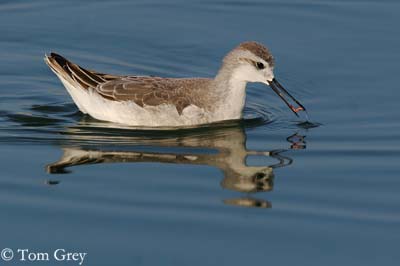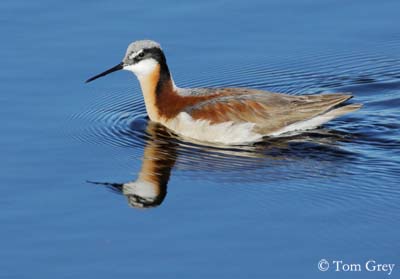
Wilson’s Phalarope
Phalaropus tricolor
Charadriiforme Order – Scolopacidae Family
BIOMETRICS:
Length: 22-24 cm
Wingspan: 38 cm
Weight: male : 30-110 g ; female : 52-128 g
LONGEVITY: Up to 10 years
DESCRIPTION:
In this species, female is brighter in plumage and larger than male. Thin bill and legs are longer than in other phalaropes.
In breeding plumage, female has grey back, with chestnut and black on the wings. She has broad black streak from the bill, through the eye extending down to neck sides. Head is grey above this line and white below.
The foreneck is pink-salmon. Rump and sides of underparts are pure white.
PROTECTION / THREATS / STATUS:
Destruction and drainage of wetlands reduce the breeding areas of this species. But the Wilson’s Phalarope is able to adapt itself to the new habitat.
Protection of the breeding areas or other areas used for nesting is important for this species, in order to keep stable populations.
They also have predators, such as the Hen Harrier (Circus cyaneus).
Fr: Phalarope de Wilson
All : Wilsonwassertreter
Esp : Falaropo Tricolor
Ital : Falaropo di Wilson
Nd : Grote Franjepoot
Russe : Американский плавунчик
Sd : Wilsonsimsnäppa
Photographer:
Tom Grey
Tom Grey's Bird Pictures
Text by Nicole Bouglouan
Sources:
HANDBOOK OF THE BIRDS OF THE WORLD Volume 3 by Josep del Hoyo-Andrew Elliott-Jordi Sargatal - Lynx Edicions - ISBN : 8487334202
FIELD GUIDE TO THE BIRDS OF NORTH AMERICA - National Geographic Society - ISBN: 0792274512
SHOREBIRDS by Peter Hayman, John Marchant and Tony Prater – Christopher Helm – 1986 – ISBN: 0747014035
GUIDE DES LIMICOLES de D. Taylor - Delachaux et Niestlé - ISBN : 2603014080
Bird Web (Seattle Audubon Society)
Wikipedia (Wikipedia, The Free Encyclopedia)
What Bird-The ultimate Bird Guide (Mitchell Waite)

Male varies in colour, but it is grey above and white below, with white face and throat. The rear neck is brownish, the foreneck is white, both separated by black eye line.
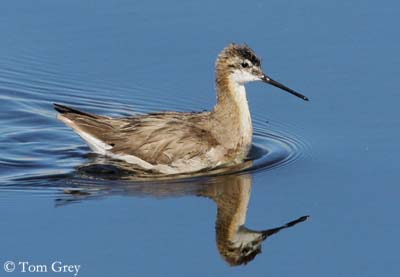
In breeding plumage, both adults have black legs.
In basic plumage, they are similar, grey above and white below with yellow legs. Face is white, throat is grey.
In flight, they appear pure white below. Wings are grey, without any white band. Rump is white and tail is pale grey.
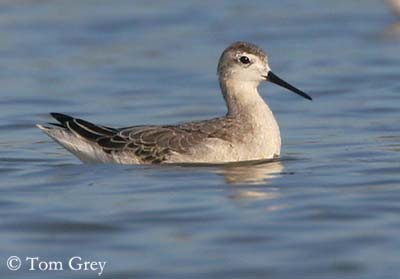
Juvenile is similar, but it shows grey-brown spots above. The plumage changes very quickly.
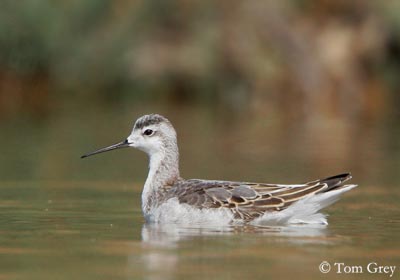
VOICE: SOUNDS BY XENO-CANTO
Wilson’s Phalarope’s typical call is a relatively low “coin-coin”. It may resemble distant dog’s bark. We can also hear raucous “wourk”, or soft “quoit-quoit-quoit”.
Contact call in flight is a brief and nasal “vittt”.
HABITAT AND RANGE:
It is a North American species. Wilson’s Phalarope breeds close to freshwater marshes and in wet grasslands in Western Centre of North America. Except in mountainous areas, this bird lives in wet areas.
During migrations, we can see this species in small groups in saltwater lakes. It winters near large shallow ponds and salt marches, in southern South America, Bolivia, Chile and Argentina.
BEHAVIOUR:
Wilson’s Phalarope does not swim very often because its legs are not webbed.
To feed, it turns into the water, drawing short circles (about 60/minute), involving the rising of several invertebrates to the surface, and by moving the water by lateral movements of the bill. It catches rapidly the preys, numerous invertebrates present in wet areas.
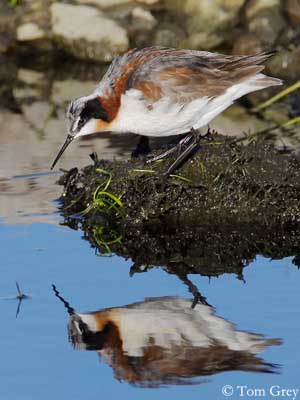
It also hunts by walking on the shore, bending its head forwards, in order to catch insects. When feeding on the ground, it rapidly runs thanks to its partially flexible legs. At other moments, it remains in front of the waves, waiting for the insects carried by the wind.
Female is larger than male and defends the territory. After laying the eggs, she mates again with one or several males, while the first male incubates the eggs and rears the young. However, she chases the other males from the nest and both mates defend the chicks.
The male prepares several places for nesting, and female chooses the nest-site.
Wilson’s Phalarope is migratory. Female leaves first the nesting areas, and male follows her when young are independent. They migrate to the large salt lakes of western United States for moulting, before to go to South America for wintering. They perform long-distance flights, of more than two days.
In this species, the female courts the male. Displays are partially aerial. The other part occurs on the water. The female swims towards her future mate, with held neck in order to expose her feathers, and utters a kind of repeated low calls.
In order to defend the young against potential predators, parents use the “broken wing” method for drawing the intruders far from the nest.
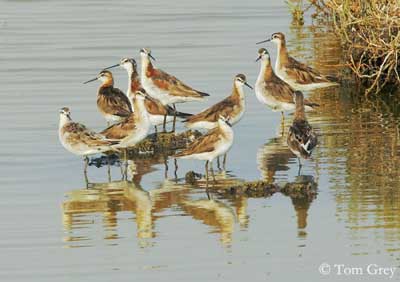
Wilson’s Phalaropes moult near the salt lakes, in a short period of up to 35-40 days. During this period, the food resources found in the lakes (prawns and flies) give them the necessary energy for recovering their plumage, and allow them to double in weight.
FLIGHT:
During the breeding season, Wilson’s Phalarope female chases the male in flight.
This bird is able to fly during about 54 hours without any stopover, in order to reach its wintering areas in South America.
REPRODUCTION:
The female arrives first on breeding areas. When the male arrives, the females mix with several males and some of them mate with them, but usually, they are monogamous.
As soon as the female chose the nest-site among all those prepared by the male, it builds the nest, a scrape in the ground, lined with grass. The nest is concealed among the dense vegetation, tall grasses or sedges, close to the water.
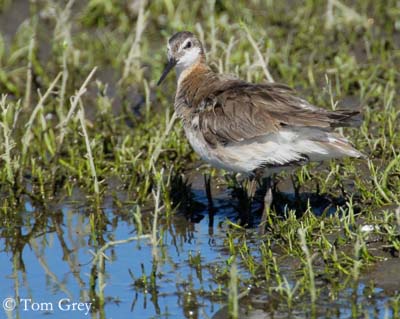
Female lays 4 spotted buff, brown or black eggs, between early May and late June, at 24 hours intervals. The male incubates the eggs alone during about 16-21 days, and care for the young.
They leave the nest one day after hatching and are able to feed themselves. They can fly at 19 days of age.
This species produces one or two broods per season, but may replace several broods if necessary.
DIET:
Wilson’s Phalarope feeds on aquatic insects and small crustaceans. It consumes flies and prawns in salt lakes, which are highly nutritive food.
It also may feed on seeds from aquatic plant, and it also takes spiders.
Young take the same food.
